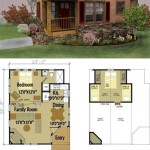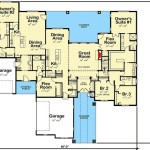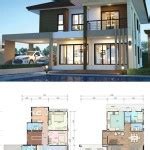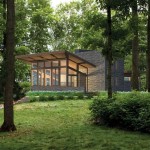A rectangular house plan is a type of floor plan in which the exterior walls of a house form a rectangle. This is one of the most common types of house plans, as it is simple to design and build. Rectangular house plans can be used for a variety of different house styles, from traditional to contemporary.
One of the main advantages of a rectangular house plan is that it is very efficient in terms of space utilization. The rectangular shape allows for a maximum amount of usable space within the house, and there are no wasted areas. Additionally, rectangular house plans are relatively easy to add on to, which can be a valuable feature if you are planning to expand your home in the future.
In this article, we will explore the different aspects of rectangular house plans, including their advantages and disadvantages. We will also provide some tips on how to design a rectangular house plan that is both functional and stylish.
Here are 8 important points about rectangular house plans:
- Efficient use of space
- Simple to design and build
- Can be used for a variety of house styles
- Easy to add on to
- May have limited natural light
- Can be monotonous if not designed carefully
- May not be suitable for all lot shapes
- Can be more expensive to build than other house plans
Overall, rectangular house plans are a good option for those who want a simple, efficient, and affordable home. However, it is important to be aware of the potential disadvantages before making a decision.
Efficient use of space
One of the main advantages of a rectangular house plan is that it is very efficient in terms of space utilization. The rectangular shape allows for a maximum amount of usable space within the house, and there are no wasted areas. This is in contrast to other house plans, such as L-shaped or U-shaped plans, which can have awkward angles and wasted space.
- Compact design: Rectangular house plans are typically more compact than other types of house plans, which means that they can fit on smaller lots. This can be a valuable feature in areas where land is expensive or scarce.
- Open floor plans: Rectangular house plans lend themselves well to open floor plans, which can make the home feel more spacious and airy. Open floor plans are also great for entertaining guests and for keeping an eye on children.
- Efficient traffic flow: The rectangular shape of a house plan also allows for efficient traffic flow. This means that people can move around the house easily without having to navigate through narrow hallways or awkward angles.
- Less wasted space: As mentioned above, rectangular house plans have no wasted space. This is because the rectangular shape allows for all of the space in the house to be used efficiently.
Overall, the efficient use of space is one of the main advantages of a rectangular house plan. This type of floor plan can help you to save money on land and construction costs, and it can also make your home feel more spacious and comfortable.
Simple to design and build
Another advantage of a rectangular house plan is that it is simple to design and build. This is because the rectangular shape is a very basic and straightforward form, which makes it easy for architects and builders to work with. Additionally, rectangular house plans do not require any special materials or construction techniques, which can save you money on construction costs.
- Fewer complex angles: One of the things that makes rectangular house plans simple to build is that they have fewer complex angles than other types of house plans. This means that there is less chance for errors during construction, and it also makes the framing process easier.
- Standard materials: Rectangular house plans can be built using standard materials, such as lumber and drywall. This means that you will not have to pay a premium for custom materials, and it also makes it easier to find contractors who are familiar with building rectangular houses.
- Faster construction times: Because rectangular house plans are simple to design and build, they can be constructed more quickly than other types of house plans. This can save you money on construction costs, and it can also allow you to move into your new home sooner.
- Less waste: Rectangular house plans also produce less waste than other types of house plans. This is because the rectangular shape allows for all of the materials to be used efficiently, with minimal waste.
Overall, the simplicity of rectangular house plans makes them a good option for those who want to save money on construction costs and who want to move into their new home quickly.
Can be used for a variety of house styles
Another advantage of a rectangular house plan is that it can be used for a variety of house styles. This is because the rectangular shape is a very versatile form, which can be adapted to suit a wide range of architectural styles. Some of the most popular house styles that use rectangular floor plans include:
- Traditional: Traditional house styles, such as Colonial and Victorian homes, often use rectangular floor plans. This is because the rectangular shape is well-suited to the symmetrical and balanced facades that are characteristic of these styles.
- Contemporary: Contemporary house styles, such as modern and minimalist homes, also often use rectangular floor plans. This is because the rectangular shape can create a clean and uncluttered look, which is desirable in these styles.
- Craftsman: Craftsman houses are known for their simple and rustic charm. Rectangular floor plans are often used in Craftsman homes, as they can help to create a warm and inviting atmosphere.
- Ranch: Ranch houses are typically long and low, with a rectangular floor plan. This type of floor plan is well-suited to the open and informal lifestyle that is associated with ranch homes.
Overall, the versatility of rectangular house plans makes them a good option for those who want a home that can be adapted to their own personal style.
Easy to add on to
One of the main advantages of a rectangular house plan is that it is easy to add on to. This is because the rectangular shape provides a simple and straightforward framework for expanding the home. Additionally, rectangular house plans often have a symmetrical design, which makes it easy to add on to either side of the house.
- Flexibility: Rectangular house plans offer a great deal of flexibility when it comes to adding on. This is because the rectangular shape can be easily extended in any direction. This makes it easy to add on a new room, a garage, or even a whole new wing to the house.
- Cost-effective: Adding on to a rectangular house plan is typically more cost-effective than adding on to other types of house plans. This is because the rectangular shape allows for efficient use of space, which can reduce the cost of materials and labor.
- Increased value: Adding on to a rectangular house plan can increase the value of the home. This is because additional space is always a valuable commodity, and it can make the home more attractive to potential buyers.
Overall, the ease of adding on to a rectangular house plan is a major advantage for those who want a home that can grow with their needs.
Here are some specific examples of how you can add on to a rectangular house plan:
- Add a new room: One of the most common ways to add on to a rectangular house plan is to add a new room. This could be a bedroom, a bathroom, a family room, or any other type of room that you need.
- Add a garage: Another popular way to add on to a rectangular house plan is to add a garage. This can be a great way to add storage space for your vehicles and other belongings.
- Add a new wing: If you need more space, you can even add a whole new wing to your rectangular house plan. This could include a master suite, a guest suite, or any other type of space that you need.
No matter what your needs are, a rectangular house plan can be easily adapted to accommodate them. This makes it a great option for those who want a home that can grow with their needs.
May have limited natural light
One potential disadvantage of a rectangular house plan is that it may have limited natural light. This is because the rectangular shape can create long, narrow rooms that are difficult to light naturally. Additionally, rectangular house plans often have fewer windows than other types of house plans, as the long walls can make it difficult to place windows without compromising the structural integrity of the house.
- Long, narrow rooms: Rectangular house plans can often have long, narrow rooms, which can be difficult to light naturally. This is because the light from windows does not penetrate very far into a long, narrow room. As a result, the back of the room can be dark and gloomy, even on a sunny day.
- Fewer windows: Rectangular house plans often have fewer windows than other types of house plans. This is because the long walls of a rectangular house can make it difficult to place windows without compromising the structural integrity of the house. Additionally, windows can be expensive to install, so builders may opt to install fewer windows in a rectangular house plan in order to save money.
- North-facing windows: If a rectangular house plan is oriented north-south, the long walls of the house will face east and west. This means that the windows on the long walls will only receive direct sunlight for a few hours each day. As a result, the rooms in the house may be dark and gloomy for most of the day.
- Overhangs and eaves: Overhangs and eaves can also block natural light from entering a rectangular house. This is because the overhangs and eaves can cast shadows on the windows, which can make it difficult for light to penetrate into the house.
If you are considering a rectangular house plan, it is important to be aware of the potential for limited natural light. You can mitigate this problem by choosing a house plan with a compact design and by placing windows strategically throughout the house. Additionally, you can use skylights and other natural lighting strategies to brighten up the interior of your home.
Can be monotonous if not designed carefully
Another potential disadvantage of a rectangular house plan is that it can be monotonous if not designed carefully. This is because the rectangular shape can create a repetitive and uninspired look. Additionally, rectangular house plans often have long, straight walls, which can make the house feel boxy and claustrophobic.
Here are some specific ways in which a rectangular house plan can become monotonous:
- Repetitive facade: The facade of a rectangular house plan can be repetitive if it consists of a series of identical windows and doors. This can create a boring and uninviting look.
- Long, straight walls: The long, straight walls of a rectangular house plan can make the house feel boxy and claustrophobic. This is especially true if the walls are not broken up by windows, doors, or other architectural features.
- Lack of interest: Rectangular house plans can lack interest if they do not have any unique or distinctive features. This can make the house look bland and forgettable.
- Poorly placed windows: Windows can be used to add interest and character to a rectangular house plan. However, if the windows are poorly placed, they can actually make the house look more monotonous. For example, if all of the windows are placed in a row along the front of the house, it can create a very boring and uninspired look.
To avoid making a rectangular house plan monotonous, it is important to carefully consider the design of the facade, the placement of the windows, and the overall proportions of the house. Additionally, it is important to use a variety of architectural features to break up the long, straight walls and add interest to the house.
Here are some tips for designing a rectangular house plan that is not monotonous:
- Use a variety of window shapes and sizes: Instead of using the same window shape and size throughout the house, use a variety of shapes and sizes to add interest to the facade.
- Place windows strategically: Windows can be used to create focal points and draw attention to certain features of the house. Place windows strategically to create a more visually appealing facade.
- Break up the long, straight walls: Long, straight walls can be broken up by using architectural features such as columns, pilasters, and porches. These features can add interest and character to the house.
- Add dormers and other roof features: Dormers and other roof features can add interest and character to a rectangular house plan. These features can also help to break up the long, straight lines of the roof.
- Use a variety of exterior materials: Using a variety of exterior materials can add interest and character to a rectangular house plan. For example, you could use stone, brick, and siding to create a more visually appealing facade.
By following these tips, you can design a rectangular house plan that is both visually appealing and functional.
May not be suitable for all lot shapes
Rectangular house plans are most suitable for rectangular or square lots. However, they can also be adapted to fit on other lot shapes, such as L-shaped or pie-shaped lots. However, it is important to note that some modifications may be necessary to make the house plan fit on the lot.
- L-shaped lots: L-shaped lots can be challenging to fit a rectangular house plan on, as the house will need to be placed in the corner of the lot. This can result in a loss of usable space in the backyard. Additionally, the house may need to be designed with a longer and narrower footprint, which can make it difficult to find furniture that fits well in the space.
- Pie-shaped lots: Pie-shaped lots are another challenging lot shape for rectangular house plans. This is because the lot is wider at the front than it is at the back. As a result, the house will need to be placed at an angle on the lot, which can make it difficult to orient the rooms in the house properly.
- Sloped lots: Sloped lots can also be difficult to fit a rectangular house plan on. This is because the house will need to be built on a foundation that is level, which can be expensive and time-consuming. Additionally, the house may need to be designed with a split-level or walk-out basement, which can add to the cost of construction.
- Narrow lots: Narrow lots can also be difficult to fit a rectangular house plan on. This is because the house will need to be built with a long and narrow footprint, which can make it difficult to find furniture that fits well in the space. Additionally, the house may need to be designed with a two-story or three-story layout, which can add to the cost of construction.
If you are considering building a rectangular house on a lot that is not rectangular or square, it is important to consult with an architect or builder to discuss the feasibility of the project. They can help you determine if a rectangular house plan is the right choice for your lot and can help you design a house that fits well on the lot.
Can be more expensive to build than other house plans
Rectangular house plans can be more expensive to build than other house plans due to their simple and straightforward design. This is because rectangular house plans require more materials and labor to construct than other types of house plans. Additionally, rectangular house plans often have more complex rooflines and exterior details, which can also add to the cost of construction.
Here are some specific factors that can contribute to the higher cost of building a rectangular house plan:
- More materials: Rectangular house plans require more materials to construct than other types of house plans. This is because the rectangular shape requires more lumber, siding, and roofing materials. Additionally, rectangular house plans often have more complex rooflines and exterior details, which can also require more materials.
- More labor: Rectangular house plans require more labor to construct than other types of house plans. This is because the rectangular shape is more difficult to frame and build than other shapes. Additionally, rectangular house plans often have more complex rooflines and exterior details, which can also require more labor to install.
- More complex rooflines: Rectangular house plans often have more complex rooflines than other types of house plans. This is because the rectangular shape requires more roof trusses and other structural components to support the roof. Additionally, rectangular house plans often have more dormers, chimneys, and other roof features, which can also add to the complexity of the roofline.
- More exterior details: Rectangular house plans often have more exterior details than other types of house plans. This is because the rectangular shape provides a more canvas for adding architectural details. Additionally, rectangular house plans often have more windows, doors, and other exterior features, which can also add to the cost of construction.
Overall, rectangular house plans can be more expensive to build than other types of house plans due to their simple and straightforward design. However, the additional cost of construction can be worth it for those who want a home that is both stylish and functional.










Related Posts








